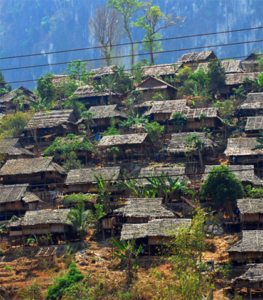Three decades of camp misery continues
As moves to encourage Burmese refugees living Thailand to return home escalate, many of the exiles say they fear for their futures if forced to return.
At the moment, refugees in Thailand have three options: repatriation to their country of origin, local integration or resettlement in a third country.
But as the Thai government loses patience with the continued presence of the camps, almost 100,000 refugees face an uncertain future.
Melbourne based Karen community leader Hsar Thain Ju, who still has family members in the Mae La camp, says even though his fellow Karen are being urged to return to Burma, it is not safe to do so.
“There are about 31,000 refugees in Mae La, the largest of nine camps on the Thai-Myanmar border. Some people have lived there for decades,” Mr Thain said.
“It is not safe for them to go back and they do not know what will happen to them if they stay in Thailand,” he said.
There are 97,439 refugees from Myanmar in the camps – half of them children – according to the UN refugee agency UNHCR.
Most are ethnic minorities who fled fighting between the military and ethnic armed groups.
Some have lived in the camps for more than 30 years – one of the world’s most protracted refugee situations.
Thailand is not a signatory to the 1951 Refugee Convention or its 1967 Protocol, which spell out the minimum standards and legal obligations towards refugee s.
s.
However, it has pledged to develop a screening system for refugees to curb trafficking, and to provide access to education, healthcare and birth registration.
But refugees live in limbo as they are not legally allowed to work or to leave the camp except for specified reasons.
“The older refugees still want to go back to Myanmar, because they left behind a home or land and they are still attached to it,” Mr Thain said.
“Many younger ones know they have nothing to go back to. Some have only known the camp, and would rather be in a city in Thailand (where) they are able to get a job and a home.”
Since 2005, more than 90,000 have been resettled in the United States, Australia and Canada and other countries, according to UNHCR. But the resettlement program for refugees from Myanmar ended in 2016.
Thousands returned to Myanmar after a democratically elected government took charge, and hundreds more have signed up for facilitated voluntary return with UNHCR.
But fighting continues in several ethnic regions despite a nationwide ceasefire agreement in 2015.
The route of taking Thai citizenship is long and arduous even though changes in the laws in 2016 opened a path for some 80,000 stateless persons, mainly from Myanmar.
Members of a junior soccer team who were rescued last July from a flooded cave in northern Thailand were granted citizenship in weeks under these provisions.
Meanwhile in the camps, services by charities have reduced since peace talks began in Myanmar, campaigners said.
Thousands of refugees have left the camps to live elsewhere in Thailand, despite the risk of arrest.
As they are not legally permitted to work, refugees often engage in work that is “unauthorised and characterised as dangerous and degrading,” according to Human Rights Watch (HRW).
And most refugee children are unable to attend school in Thailand due to restrictions on movement, as well as language barriers and discriminatory treatment, HRW says.
“Many of the refugees don’t even want citizenship; they just want to get an education, work legally, and have freedom of movement,” Mr Thain said.
“If Thai authorities decide to close the camps tomorrow, and they are all loaded onto trucks and dropped off on the other side of the border, what will they do? They should have a plan, and they should have some skills,” he said.
Mae La, a sprawling expanse of thatched bamboo huts ringed with barbed wire and set among hills, was established in 1984.
It is considered better off than the other camps – all called “temporary shelters” – as it has electricity and mobile and internet services, as well as schools until Year 12.
There are also shops, clinics, community centres, playgrounds and places of worship.
In Mae La’s Zone C, there is a bustling market of shops selling household articles, food and snacks; there are also tailors and hair salons. Motorbikes, which refugees are not officially allowed to own, are parked everywhere.
But the makeshift homes are crowded together next to open drains. Depression is common, as is alcohol and substance abuse.
The suicide rate in Mae La is three times the global average, according to a 2017 report by the International Organisation for Migration (IOM).
Since Myanmar transitioned to a civilian government, the Thai authorities have said they want to close all the camps.
Developments in Myanmar offer “real opportunities for safe and dignified voluntary return,” a UNHCR statement said.
If some individuals were unable to return, then UNHCR and the Thai authorities would handle them on a case-by-case basis, the statement said.
But community leaders say it is premature to send people home.
“If the camps are closed now, it would leave refugees vulnerable to traffickers and other dangers,” Mr Thain said.
“Instead, maybe the Thais should open up employment opportunities for them to settle in Thailand and contribute to the country’s economy,” he said.
Laurie Nowell
AMES Australia Senior Journalist












